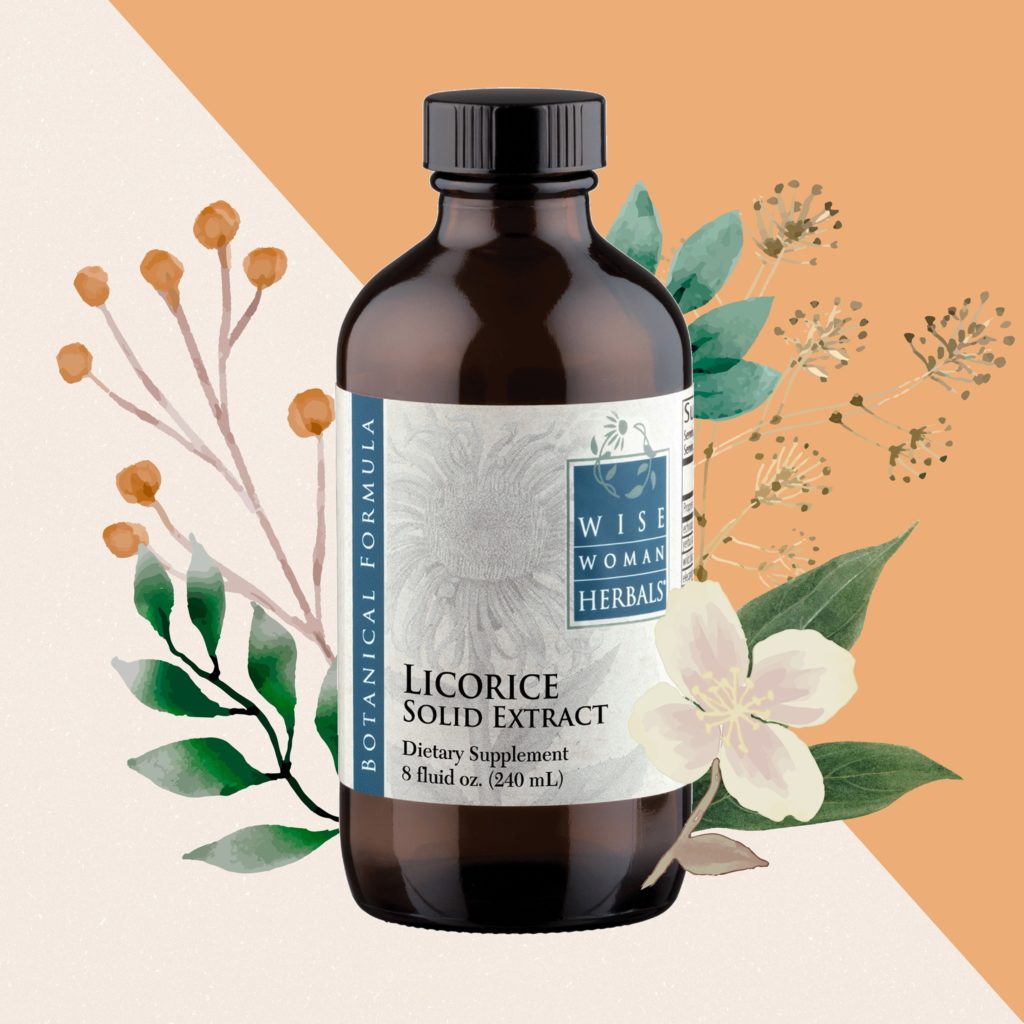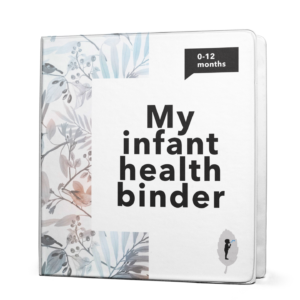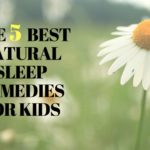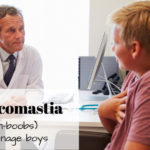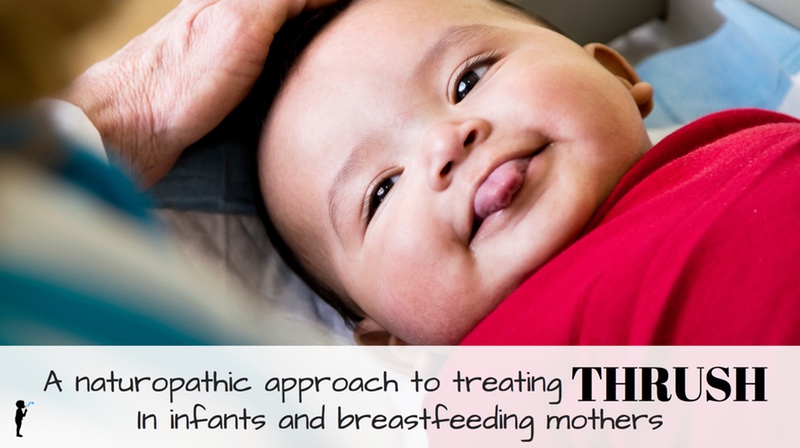
A Naturopathic Approach to Treating Thrush in Infants and Breastfeeding mothers
Lisa* brought her 7 week old infant Annabelle* in to see me with concerns about a rash and a thick white coating on the infant’s tongue that wouldn’t go away. Lisa had a normal, healthy vaginal birth with no complications but did mention that she took Antibiotic medication at 38 weeks of pregnancy. The white coating on Annabelle’s tongue started when she was about 3 weeks old and hadn’t changed in any way since. When asked about breastfeeding, Lisa responded that went well in the beginning but in the last week or so her nipples had become very sore and painful.
Based on their story and the physical exam, I suspected that baby Annabelle had oral Thrush and Lisa had thrush around her nipples. We successfully treated it (in both of them) with some natural herbs, probiotics, and minimal dietary counseling.
What is Oral Thrush?
Oral thrush, (aka Oral Candidiasis) is a fungal infection most commonly due an overgrowth of the Candida albicans species, a fungal microorganism that normally lives on our skin and mucous membranes. In healthy individuals, candidal infections are most common in the first year of life as oral thrush or diaper dermatitis (“diaper rash”). Candida albicans is also a common culprit for vulvovaginitis or vaginal yeast infections in women.
Thrush occurs in approximately 2-5% of healthy newborns and a slightly higher percentage of infants in the first year of life.
How do I know if my baby or I have Oral Thrush?
Signs and symptoms of Oral Thrush in babies include:
- Thick, white coating on Baby’s tongue or inside cheeks that doesn’t scrape or wipe off easily
- Infants may experience discomfort, poor feeding, or fussiness
- Mothers may have painful nipples during breastfeeding
- The skin on the nipple and areola become discolored (pink or darker in color) and cracked.
How does Thrush affect the breastfeeding relationship? Can moms get it?
In breastfeeding women, it is possible to pass thrush between mom and baby. Symptoms in mom may be sore cracked nipples with or without redness. It can often cause pain while breastfeeding which is challenging for mothers. Treating the mom and baby concurrently reduces the odds of the infection passing between them, without disturbing the vital breastfeeding relationship.
I want breastfeeding mothers to continue to breastfeed as long as they choose, and immediate intervention to make it as comfortable as possible is a priority.
What are risk factors to developing Thrush in babies?
Remember that Candida albicans is a normal microorganism that lives on our skin and mucous membranes. Certain medications that reduce the populations of other flora species gives Candida an opportunity to flourish, which is why it’s often referred to as an opportunistic infection. Those bugs are so happy they have more room to grow! Anytime an antibiotic medication is taken by baby or breastfeeding mom the normal flora can be disrupted in both individuals. This may be during last few weeks of pregnancy, during birth, or as a newborn. Breastfeeding mothers who may be prescribed antibiotics for mastitis infection, for example, may develop candida overgrowth on nipples and pass it on to baby.
Candida species grow best in warm, dark, wet places.
Other contributing factors to developing thrush in baby or mom include:
- Pacifiers or bottle tops that haven’t been cleaned frequently
- Not changing breast pads often
- Other medications such as corticosteroids
- Poorly controlled diabetes in breastfeeding mother
What are Treatments for Thrush?
It is not unusual for only one party in the breastfeeding relationship to develop symptoms of Thrush, but it is important to treat both mom and baby simultaneously to prevent re-infection.
- Specific probiotic strains of Lactobacillus species have been shown to inhibit Candida growth. Acidophilis is a popular probiotic strain found in yogurt that is effective. However some studies show that L. rhamnosus and L. casei exhibited stronger antifungal activity than other probiotics. Some practitioners recommend applying yogurt directly to mother’s nipple. Others recommend applying a probiotic powder with these Lactobacillus species directly to mother’s nipple – “paint the nipple” – or inside baby’s cheeks.
- Gentian violet: Research studies show gentian violet (not from Gentian or Violets) has strong anti-fungal activity against candida species. It is an inexpensive remedy that is applied topically inside baby’s cheek/lips and to mother’s nipple. Patients should be aware there is also evidence in the scientific literature that it acts as a carcinogen in mice. Be careful with use – the purple liquid can stain clothing.
- Topically, Calendula officinalis is an herb that has been shown to promote wound healing in the skin. This is a useful remedy to use topically on mother’s affected nipples. Calendula succus (pressed juice of Calendula) or ointment is often used by naturopathic doctors as a natural alternative to the potentially carcinogenic Gentian violet. It is used similarly to Gentian violet, meaning it is applied topically (“painted”) on the baby’s cheek, tongue, lips and mother’s nipple. (Note: a one-page Calendula herb guide, including medicinal constituents, uses and brief dosing guide is included in the 6 month well child guide.)
- Nystatin is an anti-fungal medication given directly to the baby to eradicate the candida overgrowth. This medication is not systemically absorbed by the baby and has very few side effects. It also comes in a cream or ointment that can be applied to mother’s nipple.
- Diflucan is another (more potent) anti-fungal medication that may also be prescribed by health care providers.
Depending on severity of infection, Naturopathic doctors often start with probiotics before considering a prescription anti-fungal medication.
Can I prevent Oral Thrush?
If a baby or breastfeeding mother has to use antibiotic medication for any reason, there are some strategies to help prevent an overgrowth of Candida. Taking probiotics with the specific Lactobacillus species mentioned above, is a great therapy to prevent Thrush.
If I’m breastfeeding should I do a Candida Cleanse?
The short answer is No. As a naturopathic doctor it may be common for me to recommend dietary changes or restrictions to explore potential food sensitivities in many of my patients. However, particularly with breastfeeding mothers, I am always very careful about recommending any elimination or restrictive diets. The last thing I want to do is decrease a mother’s nutritional intake that may negatively impact breastmilk production. Instead, I encourage mothers to emphasize eating whole-foods diet, increase foods with anti-microbial properties like garlic and onions, and drink plenty of hydrating fluids.
Conclusion:
Oral Thrush can be bothersome and disrupt the breastfeeding relationship between mother and infant. There are natural ways to prevent and treat infection that are safe and effective for both mom and baby.
Remember:
This article is intended for educational purposes only, and is not intended to diagnose or treat you or your child. If your child has any medical conditions or health concerns, please consult a naturopathic doctor prior to starting any treatments – a customized approach to treatment is always best. Do NOT give your child any nutritional supplements or medications without consulting a naturopathic doctor or other licensed healthcare professional first.
** Names were changed to protect confidentiality of the patients
References:
Dinda M1, Dasgupta U, Singh N, Bhattacharyya D, Karmakar P. PI3K-mediated proliferation of fibroblasts by Calendula officinalis tincture: implication in wound healing. Phytother Res. 2015 Apr;29(4):607-16. doi: 10.1002/ptr.5293. Epub 2015 Jan 13.
Gomes-de-Elvas AR1, Palmeira-de-Oliveira A, Gaspar C, Gouveia P, Palmeira-de-Oliveira R, Pina-Vaz C, Rodrigues AG, Martinez-de-Oliveira J. Su CW1, Gaskie S, Jamieson B, Triezenberg D. In vitro assessment of gentian violet anti- candida activity. Gynecol Obstet Invest. 2012;74(2):120-4. Epub 2012 Aug 10.
Janczarek M1, Bachanek T1, Mazur E1, Chałas R1. The role of probiotics in prevention of oral diseases. Postepy Hig Med Dosw (Online). 2016 Jan 4;70(0):850-7.
Kalyoussef, Sabah. Pediatric Candidiasis Clinical Presentation. www.medscape.com Updated: Feb 07, 2016
Lyu X1, Zhao C1, Yan ZM1, Hua H1. Efficacy of nystatin for the treatment of oral candidiasis: a systematic review and meta-analysis. Drug Des Devel Ther. 2016 Mar 16;10:1161-71. doi: 10.2147/DDDT.S100795. eCollection 2016.
Matsubara VH1,2,3, Wang Y1, Bandara HM1, Mayer MP2, Samaranayake LP4. Probiotic lactobacilli inhibit early stages of Candida albicans biofilm development by reducing their growth, cell adhesion, and filamentation. Appl Microbiol Biotechnol. 2016 Jul;100(14):6415-26. doi: 10.1007/s00253-016-7527-3. Epub 2016 Apr 18.
Mukherjee PK1, Chen H, Patton LL, Evans S, Lee A, Kumwenda J, Hakim J, Masheto G, Sawe F, Pho MT, Freedberg KA, Shiboski CH, Ghannoum MA, Salata RA Topical gentian violet compared with nystatin oral suspension for the treatment of oropharyngeal candidiasis in HIV-1-infected participants. AIDS. 2017 Jan 2;31(1):81-88
Song YG1, Lee SH2. Inhibitory effects of Lactobacillus rhamnosus and Lactobacillus casei on Candida biofilm of denture surface. Arch Oral Biol. 2016 Dec 31;76:1-6. doi: 10.1016/j.archoralbio.2016.12.014. [Epub ahead of print]
Su CW1, Gaskie S, Jamieson B, Triezenberg D. Clinical inquiries. What is the best treatment for oral thrush in healthy infants? J Fam Pract. 2008 July; 57 (7): 484-485
Yusuf Cem Kaplan, MD, Gideon Koren, MD FRCPC FACMT, Shinya Ito, MD FRCPC, and Pina Bozzo. Fluconazole Use during Breastfeeding. Can Fam Physician. 2015 Oct; 61(10): 875–876. PMCID: PMC4607332
